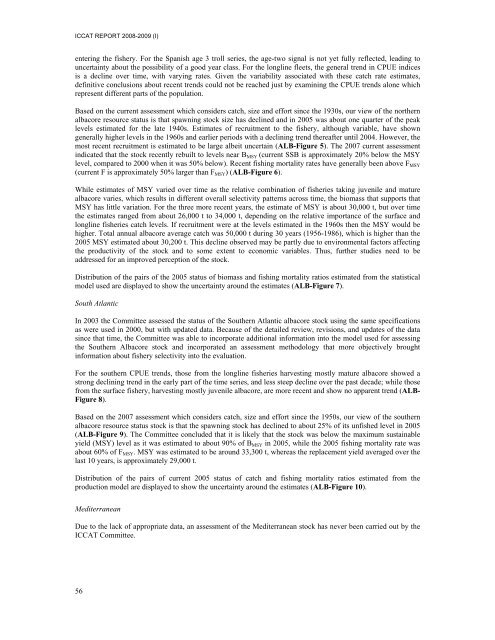REPORT OF THE STANDING COMMITTEE ON RESEARCH ... - Iccat
REPORT OF THE STANDING COMMITTEE ON RESEARCH ... - Iccat
REPORT OF THE STANDING COMMITTEE ON RESEARCH ... - Iccat
You also want an ePaper? Increase the reach of your titles
YUMPU automatically turns print PDFs into web optimized ePapers that Google loves.
ICCAT <strong>REPORT</strong> 2008-2009 (I)entering the fishery. For the Spanish age 3 troll series, the age-two signal is not yet fully reflected, leading touncertainty about the possibility of a good year class. For the longline fleets, the general trend in CPUE indicesis a decline over time, with varying rates. Given the variability associated with these catch rate estimates,definitive conclusions about recent trends could not be reached just by examining the CPUE trends alone whichrepresent different parts of the population.Based on the current assessment which considers catch, size and effort since the 1930s, our view of the northernalbacore resource status is that spawning stock size has declined and in 2005 was about one quarter of the peaklevels estimated for the late 1940s. Estimates of recruitment to the fishery, although variable, have showngenerally higher levels in the 1960s and earlier periods with a declining trend thereafter until 2004. However, themost recent recruitment is estimated to be large albeit uncertain (ALB-Figure 5). The 2007 current assessmentindicated that the stock recently rebuilt to levels near B MSY (current SSB is approximately 20% below the MSYlevel, compared to 2000 when it was 50% below). Recent fishing mortality rates have generally been above F MSY(current F is approximately 50% larger than F MSY ) (ALB-Figure 6).While estimates of MSY varied over time as the relative combination of fisheries taking juvenile and maturealbacore varies, which results in different overall selectivity patterns across time, the biomass that supports thatMSY has little variation. For the three more recent years, the estimate of MSY is about 30,000 t, but over timethe estimates ranged from about 26,000 t to 34,000 t, depending on the relative importance of the surface andlongline fisheries catch levels. If recruitment were at the levels estimated in the 1960s then the MSY would behigher. Total annual albacore average catch was 50,000 t during 30 years (1956-1986), which is higher than the2005 MSY estimated about 30,200 t. This decline observed may be partly due to environmental factors affectingthe productivity of the stock and to some extent to economic variables. Thus, further studies need to beaddressed for an improved perception of the stock.Distribution of the pairs of the 2005 status of biomass and fishing mortality ratios estimated from the statisticalmodel used are displayed to show the uncertainty around the estimates (ALB-Figure 7).South AtlanticIn 2003 the Committee assessed the status of the Southern Atlantic albacore stock using the same specificationsas were used in 2000, but with updated data. Because of the detailed review, revisions, and updates of the datasince that time, the Committee was able to incorporate additional information into the model used for assessingthe Southern Albacore stock and incorporated an assessment methodology that more objectively broughtinformation about fishery selectivity into the evaluation.For the southern CPUE trends, those from the longline fisheries harvesting mostly mature albacore showed astrong declining trend in the early part of the time series, and less steep decline over the past decade; while thosefrom the surface fishery, harvesting mostly juvenile albacore, are more recent and show no apparent trend (ALB-Figure 8).Based on the 2007 assessment which considers catch, size and effort since the 1950s, our view of the southernalbacore resource status stock is that the spawning stock has declined to about 25% of its unfished level in 2005(ALB-Figure 9). The Committee concluded that it is likely that the stock was below the maximum sustainableyield (MSY) level as it was estimated to about 90% of B MSY in 2005, while the 2005 fishing mortality rate wasabout 60% of F MSY . MSY was estimated to be around 33,300 t, whereas the replacement yield averaged over thelast 10 years, is approximately 29,000 t.Distribution of the pairs of current 2005 status of catch and fishing mortality ratios estimated from theproduction model are displayed to show the uncertainty around the estimates (ALB-Figure 10).MediterraneanDue to the lack of appropriate data, an assessment of the Mediterranean stock has never been carried out by theICCAT Committee.56
















